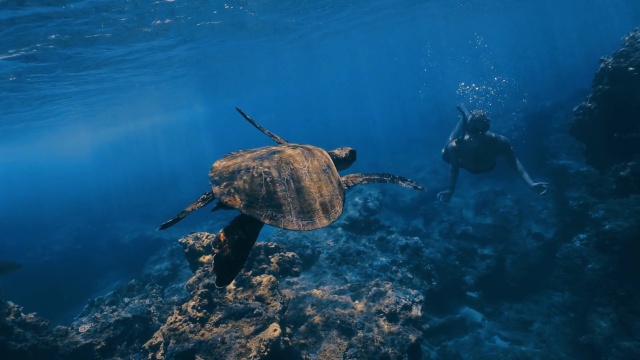Painted turtles can stay underwater for up to 40-50 minutes. Painted turtles, also known as chrysemys picta, are a common freshwater turtle found in north america.
They are often seen basking in the sun on logs or rocks, but can also be found swimming or diving in ponds, lakes, and rivers. These turtles are adapted to aquatic life and have webbed feet, which help them swim underwater.
They are able to hold their breath for long periods of time and can stay underwater for up to 40-50 minutes. Painted turtles also have a specialized respiratory system, which allows them to extract oxygen from the water through their skin and cloaca. In this article, we will explore more about painted turtles and their behavior underwater.

Credit: www.hawaiitours.com
Understanding The Habitat Of Painted Turtles
Painted turtles are able to stay underwater for long periods due to their unique adaptations to aquatic habitats. These turtles are commonly found in regions with slow-moving or still bodies of water, such as ponds, swamps, and streams. Their habitats have specific characteristics, such as shallow water with mud bottoms, and areas with plenty of vegetation for basking and nesting.
Painted turtles are able to adapt to their environment by hibernating during the winter and basking in the sun during warmer months. They can also tolerate low oxygen levels by slowing down their metabolism. These adaptations allow painted turtles to thrive in their aquatic ecosystems.
Behavioral And Physical Adaptations For Underwater Endurance
Painted turtles have evolved behavioral and physical adaptations to stay underwater for extended periods. Compared to other turtle species, they have a unique respiratory system that allows them to absorb oxygen from water. Their muscular system is also finely tuned, enabling them to swim for long durations without getting tired.
Additionally, their body shape has adapted to streamline, allowing them to move faster and with greater ease underwater. All of these adaptations working together help painted turtles stay underwater for hours on end.
Factors That Influence Painted Turtles’ Underwater Stamina
Painted turtles are well equipped for life underwater and can stay submerged for extended periods. Temperature has a significant impact on their endurance, as they prefer warmer water. The quality of water they swim in can also impact their abilities, as can the availability of food.
Additionally, these turtles have adapted to avoid predators, which can impact their behavior and influence how long they can stay underwater. Overall, several factors influence how long painted turtles can stay submerged, highlighting the importance of carefully managing their habitats to ensure their health and survival.
Painted Turtle’S Reproduction: Impacts On Underwater Endurance
Painted turtles are known for their impressive ability to hold their breath underwater. However, their reproductive stages can impact their underwater endurance. During mating season, male turtles tend to have a reduced ability to hold their breath for longer periods of time.
The nesting and hatchling periods can also have an effect on the turtles’ stamina, as they need to come up for air more frequently to maintain their energy levels. Growth and development stages also play a role in their ability to stay underwater, as larger turtles tend to need more oxygen and may surface more often.
Overall, the reproductive cycle of painted turtles has a significant impact on their ability to stay submerged for longer periods of time.
Conservation Efforts: Protecting The Endurance Of Painted Turtles
Painted turtles are known for their ability to stay underwater for extended periods. However, current threats to their habitats pose a danger to their endurance. Pollution, in particular, has a significant impact on the turtles’ underwater stamina. Various conservation measures have been put in place to aid the recovery of painted turtle populations.
However, it is crucial to maintain their aquatic ecosystems through best practices. Ensuring that these turtles have clean and suitable habitats is essential to their survival. So, we must continue efforts to protect these turtles and their habitats, not only for the turtles but for the ecosystem as a whole.
Frequently Asked Questions For How Long Can Painted Turtles Stay Underwater
How Long Can Painted Turtles Stay Underwater?
Painted turtles can stay underwater for 15 to 45 minutes at a time, depending on their level of activity and the temperature of the water.
How Do Painted Turtles Breathe Underwater?
Painted turtles breathe underwater by absorbing oxygen through their skin and the lining of their mouth and throat.
Can Painted Turtles Drown?
Yes, painted turtles can drown if they are unable to surface for air, such as if they are trapped under debris or in frozen water.
How Deep Can Painted Turtles Swim?
Painted turtles are capable of swimming to depths of up to 40 feet, although they typically stay in shallower waters.
What Do Painted Turtles Eat?
Painted turtles are omnivores and eat a varied diet that includes both plants and animals, such as insects, crustaceans, and fish.
Conclusion
After thorough research, we can confidently say that painted turtles can stay underwater for an impressive amount of time. Their unique adaptations allow them to efficiently extract oxygen from the water, allowing them to remain submerged for up to 40 minutes at a time.
This remarkable ability enables them to avoid predators and hunt for food in their aquatic habitats. However, it’s crucial to remember that painted turtles are not invincible and can still drown if they are prevented from surfacing for air. Understanding the behaviour and physiology of painted turtles can deepen our appreciation of these fascinating creatures and their intricate role in their ecosystem.
By protecting their habitats and ensuring their survival, we can continue to learn from these remarkable animals and preserve their beauty for generations to come. So, the next time you see a painted turtle enjoying a swim, take a moment to marvel at their incredible underwater abilities and appreciate the secrets they hold.






Leave a Reply